Page 208 of 324
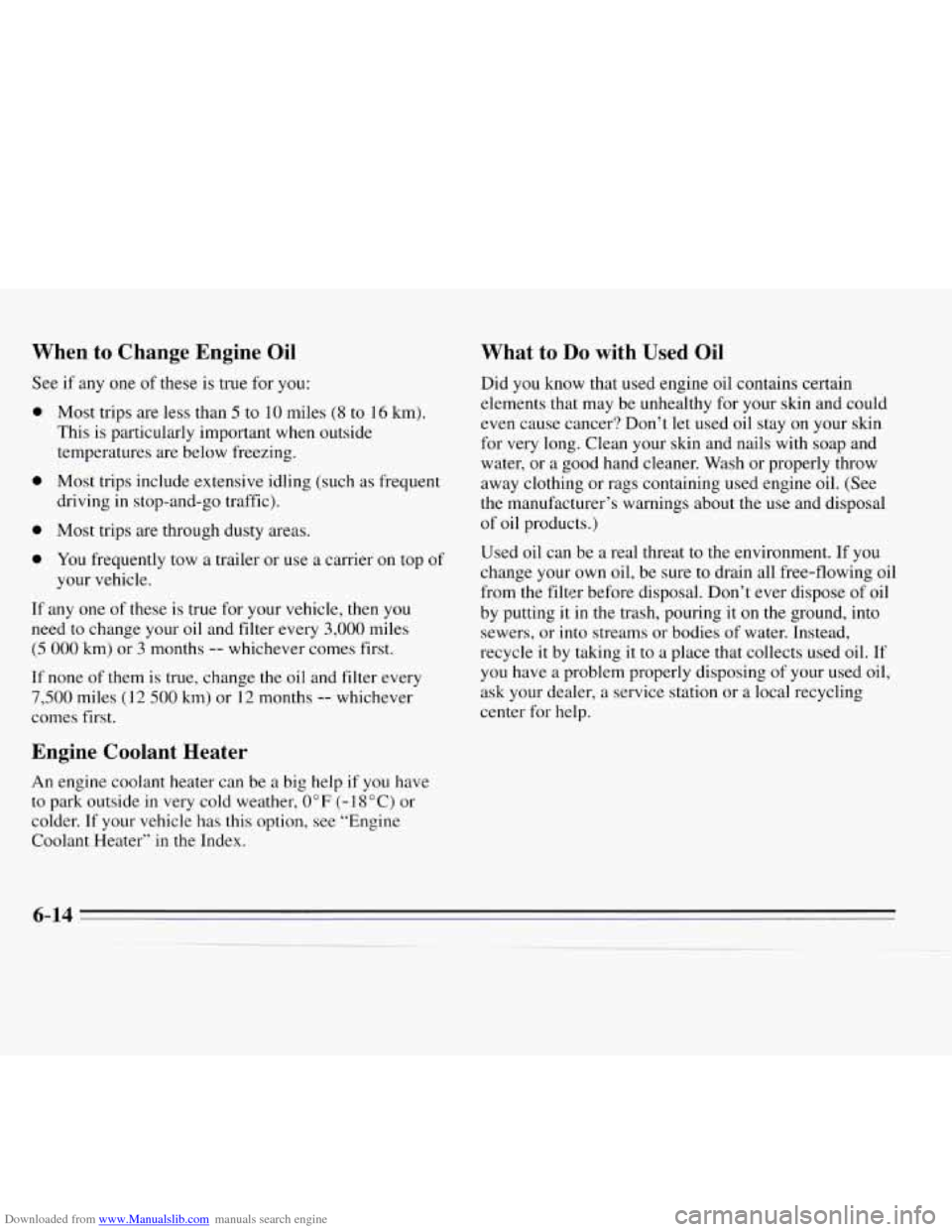
Downloaded from www.Manualslib.com manuals search engine When to Change Engine Oil
See if any one of these is true for you:
0
0
0
0
Most trips are less than 5 to 10 miles (8 to 16 km).
This is particularly important when outside
temperatures are below freezing.
Most trips include extensive idling (such as frequent
driving in stop-and-go traffic).
Most trips are through dusty areas.
You frequently tow a trailer or use
a carrier on top of
your vehicle.
If any one of these is true for your vehicle, then you
need
to change your oil and filter every 3,000 miles
(5 000 km) or 3 months -- whichever comes first.
If none of them
is true, change the oil and filter every
7,500 miles (1 2 500 km) or 12 months -- whichever
comes first.
Engine Coolant Heater
An engine coolant heater can be a big help if you have
to park outside in very cold weather,
0°F (- 18OC) or
colder. If your vehicle has this option, see “Engine
Coolant Heater”
in the Index.
What to Do with Used Oil
Did you know that used engine oil contains certain
elements that may be unhealthy for your skin and could
even cause cancer? Don’t let used oil stay on your skin
for very long. Clean your skin and nails with soap and
water, or a good hand cleaner. Wash or properly throw
away clothing or rags containing used engine oil. (See
the manufacturer’s warnings about the use and disposal
of oil products.)
Used oil can be a real threat to the environment. If you
change your own oil, be sure to drain all free-flowing oil
from the filter before disposal. Don’t ever dispose
of oil
by putting it
in the trash, pouring it on the ground, into
sewers, or into streams or bodies
of water. Instead,
recycle
it by taking it to a place that collects used oil. If
you have a problem properly disposing of your used oil,
ask your dealer, a service station or a local recycling
center for help.
Page 212 of 324
Downloaded from www.Manualslib.com manuals search engine Then, without shutting off the engine, follow these
steps:
3.1 L L82 (Code M) Engine 3.4L LQ 1 (Code X) Engine
1. The transaxle fluid dipstick handle is the red loop
near the back
of the engine. Pull out the dipstick and
wipe it with
a clean rag or paper towel.
2. Push it back in all the way, wait three seconds and
then pull
it back out again. 3.1L
L82 (Code M) Engine 3.4L LQ1 (Code X) Engine
3. Check both sides
of the dipstick, and read the lower
level. The fluid level must be in the cross-hatched
area.
4. If the fluid level is in the acceptable range, push the
dipstick back
in all the way.
6-18
Page 239 of 324
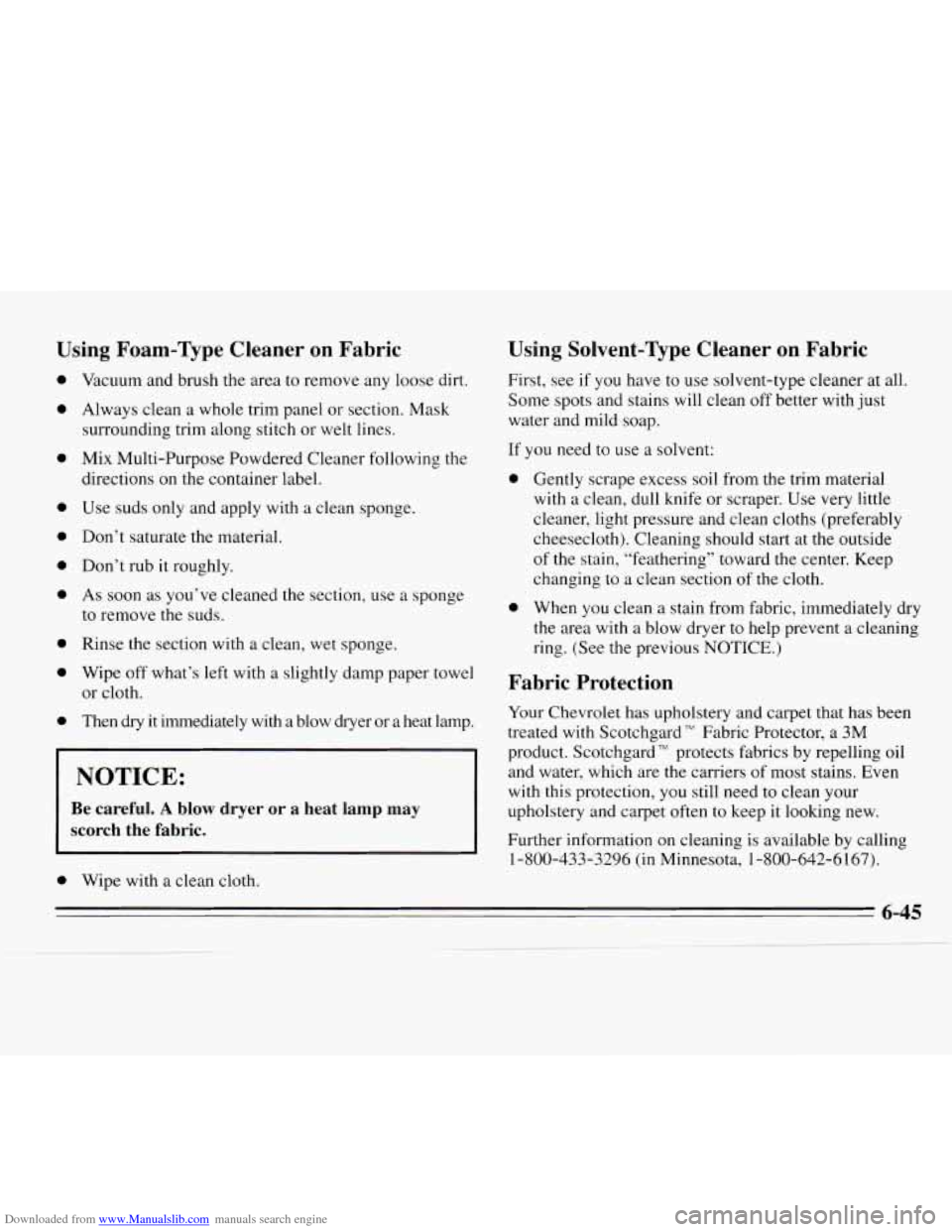
Downloaded from www.Manualslib.com manuals search engine Using Foam-Type Cleaner on Fabric
0
0
0
0
0
a
Vacuum and brush the area to remove any loose dirt.
Always clean a whole trim panel or section. Mask
surrounding trim along stitch or welt lines.
Mix Multi-Purpose Powdered Cleaner following the
directions on the container label.
Use suds only and apply with a clean sponge.
Don’t saturate the material.
Don’t rub it roughly.
As soon as you’ve cleaned the section, use a sponge
to remove the suds.
Rinse the section with a clean,
wet sponge.
Wipe off what’s left with a slightly damp paper towel
or cloth.
Then
dry it immediately with a blow dryer or a heat lamp.
NOTICE:
Be careful. A blow dryer or a heat lamp may
scorch the fabric.
0 Wipe with a clean cloth.
Using Solvent-Type Cleaner on Fabric
First, see if you have to use solvent-type cleaner at all.
Some spots and stains will clean off better with just
water and mild soap.
If you need to use a solvent:
0 Gently scrape excess soil from the trim material
with a clean, dull knife or scraper. Use very little
cleaner, light pressure and clean cloths (preferably
cheesecloth). Cleaning should start at
the outside
of the stain, “feathering” toward the center. Keep
changing to
a clean section of the cloth.
0 When you clean a stain from fabric, immediately dry
the area with a blow dryer to help prevent a cleaning
ring. (See
the previous NOTICE.)
Fabric Protection
Your Chevrolet has upholstery and carpet that has been
treated with Scotchgard” Fabric Protector, a 3M
product. Scotchgard
TM protects fabrics by repelling oil
and water, which are the carriers
of most stains. Even
with this protection, you still need
to clean your
upholstery and carpet
often to keep it looking new.
Further information on cleaning is available by calling
1-800-433-3296 (in Minnesota, 1-800-642-6167).
6-45
Page 242 of 324
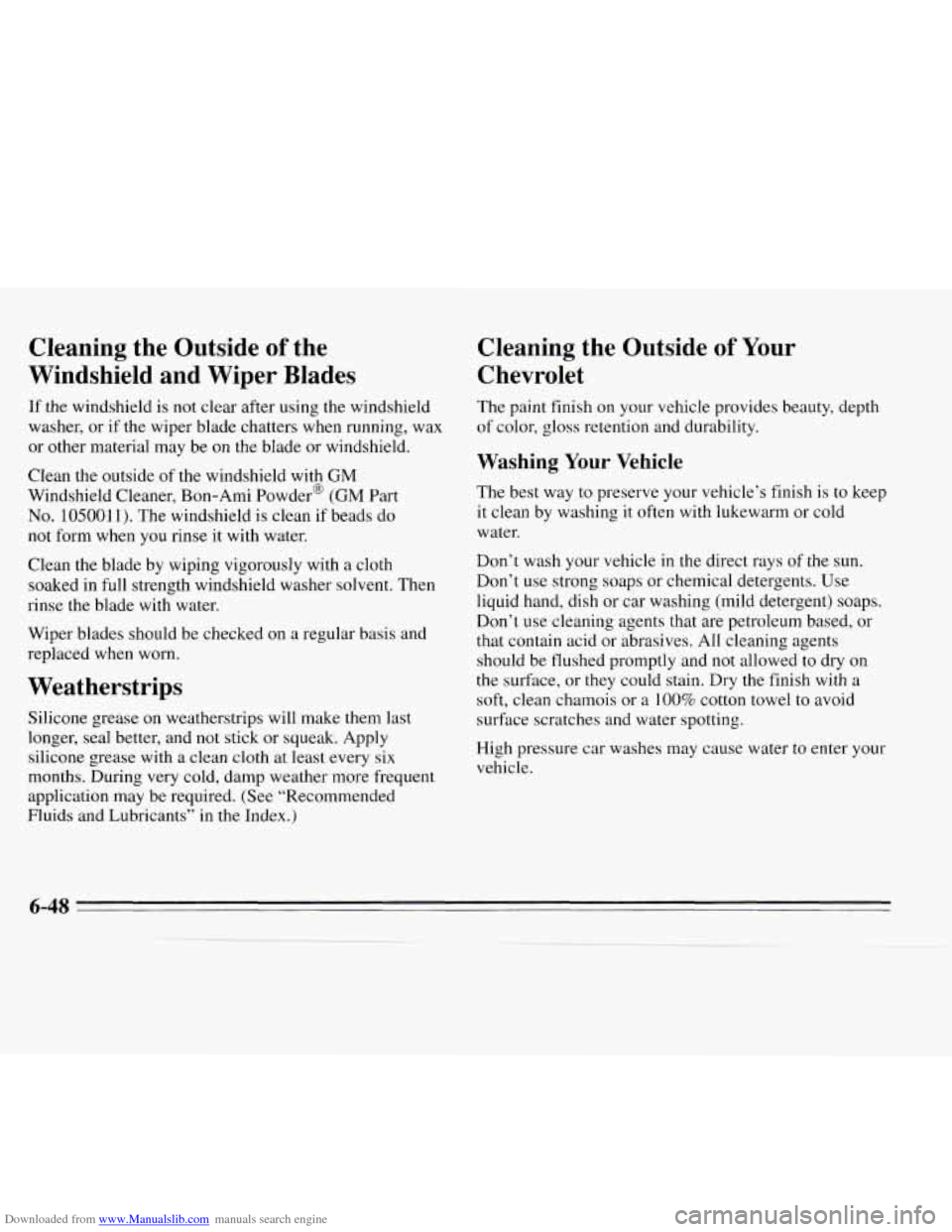
Downloaded from www.Manualslib.com manuals search engine Cleaning the Outside of the
Windshield and Wiper Blades
If the windshield is not clear after using the windshield
washer, or if the wiper blade chatters when running, wax
or other material may
be on the blade or windshield.
Clean the outside
of the windshield with GM
Windshield Cleaner, Bon-Ami Powder@ (GM Part
No. 1050011). The windshield is clean if beads do
not form when you rinse
it with water.
Clean the blade by wiping vigorously with
a cloth
soaked in full strength windshield washer solvent. Then
rinse the blade with water.
Wiper blades should be checked
on a regular basis and
replaced when worn.
Weatherstrips
Silicone grease on weatherstrips will make them last
longer, seal better, and not stick or squeak. Apply
silicone grease with
a clean cloth at least every six
months. During very cold, damp weather more frequent
application may be required. (See “Recommended
Fluids and Lubricants”
in the Index.)
Cleaning the Outside of Your
Chevrolet
The paint finish on your vehicle provides beauty, depth
of color, gloss retention and durability.
Washing Your Vehicle
The best way to preserve your vehicle’s finish is to keep
it clean by washing it often with lukewarm or cold
water.
Don’t wash your vehicle in the direct rays of the
sun.
Don’t use strong soaps or chemical detergents. Use
liquid hand, dish or car washing (mild detergent) soaps.
Don’t use cleaning agents that are petroleum based, or
that contain acid or abrasives. All cleaning agents
should be flushed promptly and
not allowed to dry on
the surface, or they could stain. Dry the finish with a
soft, clean chamois or a
100% cotton towel to avoid
surface scratches and water spotting.
High pressure car washes may cause water to enter your
vehicle.
6-48
Page 262 of 324
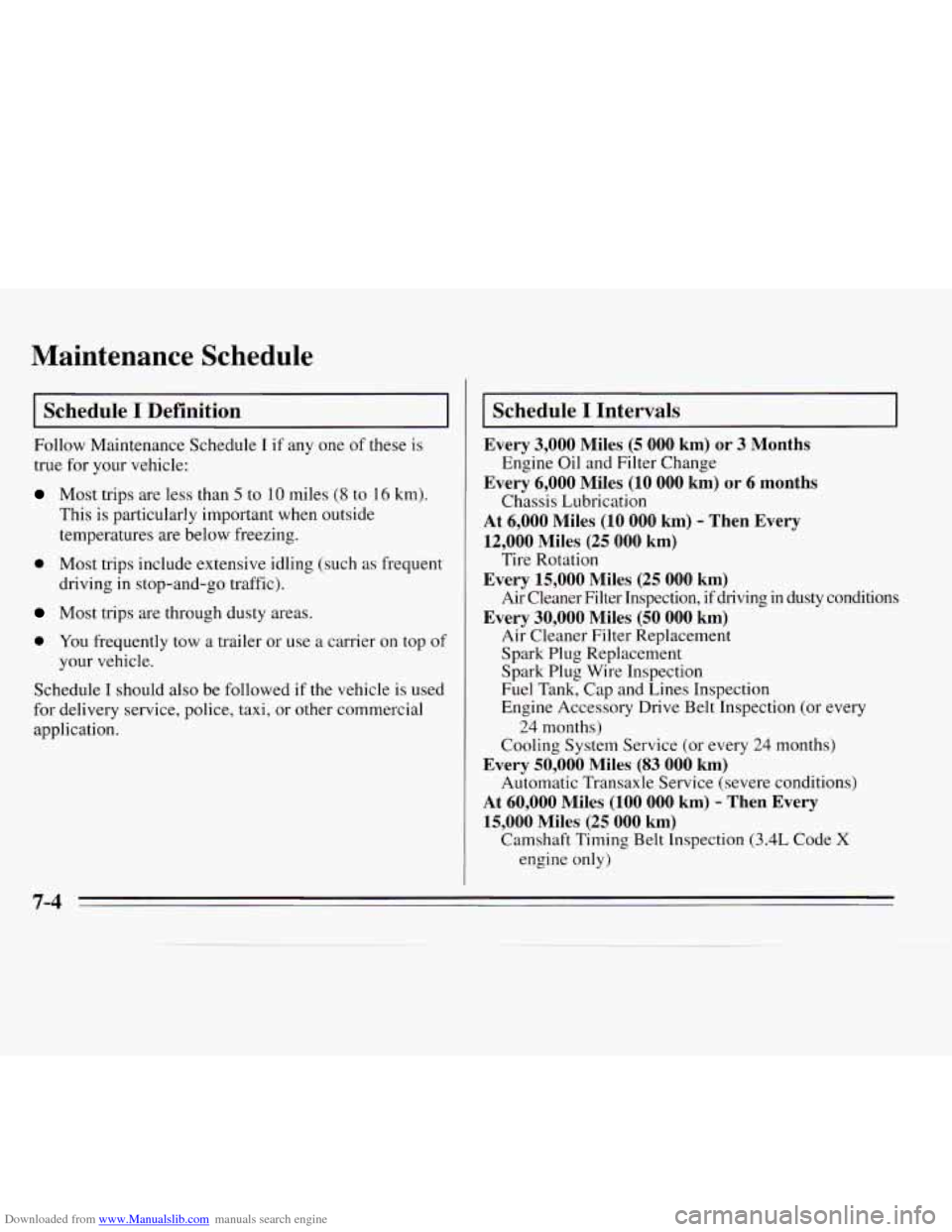
Downloaded from www.Manualslib.com manuals search engine Maintenance Schedule
Schedule I Definition
Follow Maintenance Schedule I if any one of these is
true for your vehicle:
Most trips are less than 5 to 10 miles (8 to 16 km).
This is particularly important when outside
temperatures are below freezing.
0 Most trips include extensive idling (such as frequent
driving in stop-and-go traffic).
Most trips are through dusty areas.
0 You frequently tow a trailer or use a carrier on top of
your vehicle.
Schedule
I should also be followed if the vehicle is used
for delivery service, police, taxi, or other commercial
application.
Schedule I Intervals
Every 3,000 Miles (5 000 km) or 3 Months
Engine Oil and Filter Change
Every 6,000 Miles (10 000 km) or 6 months
Chassis Lubrication
At 6,000 Miles (10 000 km) - Then Every
12,000 Miles (25
000 km)
Tire Rotation
Every 15,000 Miles (25 000 km)
Air Cleaner Filter Inspection, if dnving in dusty conditions
Every 30,000 Miles (50 000 km)
Air Cleaner Filter Replacement
Spark Plug Replacement
Spark Plug Wire Inspection
Fuel Tank,
Cap and Lines Inspection
Engine Accessory Drive Belt Inspection (or every
Cooling System Service (or every 24 months)
Automatic Transaxle Service (severe conditions)
24 months)
Every 50,000 Miles (83 000 km)
At 60,000 Miles (100 000 km) - Then Every
15,000 Miles
(25 000 km)
Camshaft Timing Belt lnspection (3.4L Code X
engine only)
7-4
Page 273 of 324
Downloaded from www.Manualslib.com manuals search engine I Maintenance Schedule I 1
50,000 Miles (83 000 km)
0 Change automatic transaxle fluid and filter
if the vehicle is mainly driven under one or
more of these conditions:
- In heavy city traffic where the outside
temperature regularly reaches
90 O F
(32°C) or higher.
- In hilly or mountainous terrain.
- When doing frequent trailer towing.
- Uses such as found in taxi, police or
If you do not use your vehicle under any of
these conditions, the fluid andfilter do not
require changing.
delivery service.
DATE
SERVICED BY: ACTUAL MILEAGE
51,000 Miles (85 000 km)
0 Change engine oil and filter (or every
3 months, whichever occurs first).
An Emission Control Service.
DATE
SERVICED BY: ACTUAL MILEAGE
Page 283 of 324
Downloaded from www.Manualslib.com manuals search engine I Maintenance Schedule I I
99,000 Miles (165 000 km)
0 Change engine oil and filter (or every
3 months, whichever occurs first).
An Emission Control Service.
I DATE I ACTUALMILEAGE ISERVICED BY1
100,000 Miles (1 66 000 km)
0 Change automatic transaxle fluid and filter
if the vehicle is mainly driven under one or
more of these conditions:
- In heavy city traffic where the outside
temperature regularly reaches
90 O F
(32°C) or higher.
- In hilly or mountainous terrain.
- When doing frequent trailer towing.
- Uses such as found in taxi, police or
If you do not use your vehicle under any of
these conditions, the fluid and filter do not
require changing.
delivery service.
7-25
Page 288 of 324
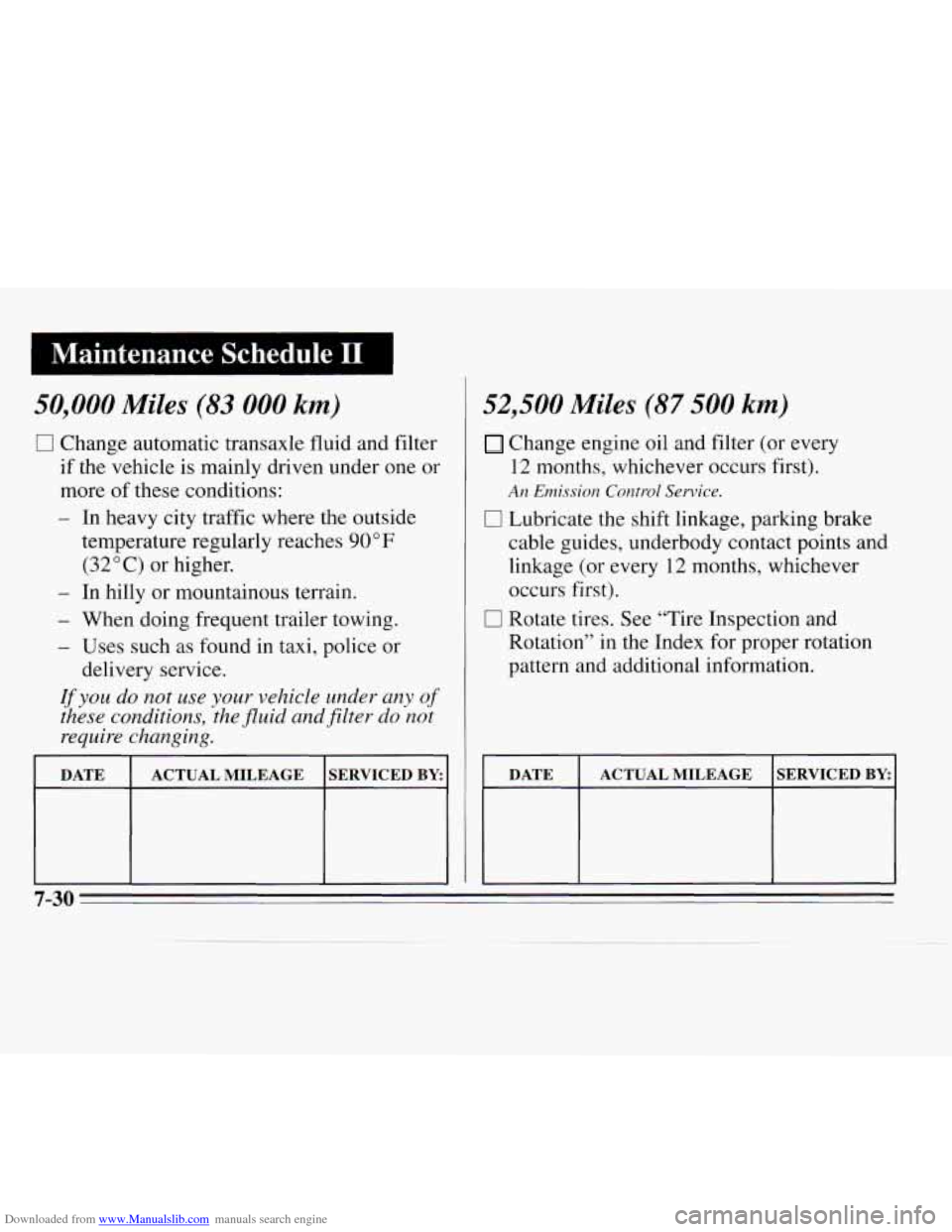
Downloaded from www.Manualslib.com manuals search engine 50,000 Miles (83 000 km)
0 Change automatic transaxle fluid and filter if
the vehicle is mainly driven under one or
more of these conditions:
- In heavy city traffic where the outside
temperature regularly reaches
90 OF
(32°C) or higher.
- In hilly or mountainous terrain.
- When doing frequent trailer towing.
- Uses such as found in taxi, police or
If you do not use your vehicle under uny of
th.ese conditions, the fluid and filter do kit
require chunging.
delivery service.
I DATE I ACTUAL MILEAGE SERVICED BYI
52,500 Miles (87 500 km)
Change engine oil and filter (or every
12 months, whichever occurs first).
An Emission Control Service.
0 Lubricate the shift linkage, parking brake
cable guides, underbody contact points and linkage (or every
12 months, whichever
occurs first).
0 Rotate tires. See “Tire Inspection and
Rotation”
in the Index for proper rotation
pattern and additional information.
DATE SERVICED BY ACTUAL MILEAGE
7-30